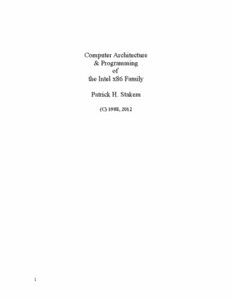Download Computer Architecture & Programming of the Intel x86 Family PDF Free - Full Version
Download Computer Architecture & Programming of the Intel x86 Family by Patrick H. Stakem in PDF format completely FREE. No registration required, no payment needed. Get instant access to this valuable resource on PDFdrive.to!
About Computer Architecture & Programming of the Intel x86 Family
This book is an introduction to computer architecture, hardware and software, presented in the context of the Intel x86 family. The x86 describes not only a line of microprocessor chips dating back to 1978, but also an instruction set architecture (ISA) that the chips implement. The chip families were built by Intel and other manufacturers, and execute the same instructions, but in different manners. The results are the same, arithmetically and logically, but may differ in their timing.Why the focus on the Intel x86? It was the basis of the IBM personal computer (PC) family and its spin-offs. It has transitioned from a 16 to a 32 to a 64-bit architecture, keeping compatibility for more than 30 years. It's an de-facto industry standard that has withstood the test of time.This book covers the Intel ISA-16 and ISA-32 architectures from the 8086/8088 to the Pentium, including the math coprocessors. A chart of ISA processors is included.The purpose of this book is to provide the basic background information for an understanding of the 80x86 family, the IBM Personal Computer (pc), and programming in assembly language as an introduction to the broader field of Computer Architecture. It will stress the pervasiveness of this pc-based technology in everyday things and events. It will provide an introduction to Software System Engineering and the Design for Debugging methodology. This book is a spin-off of a course in Computer Architecture/System Integration, taught in the graduate Engineering Science Program at Loyola College (now, Loyola University in Maryland).If we learn to program in the language c, for example, we can take our skills to any computer with a set of c-based tools. If we learn IA-32 assembly language, we have to relearn a language if we switch to a different architecture.So, why do we learn assembly language? Because it gives us insight into the underlying hardware, how it is organized, and how it operates.This book is dedicated to the graduate students in Engineering Science at Loyola College, Columbia Campus, who took the course EG-611, “System Integration I, the x86 Architecture and Assembly Language.” The course was given to hundreds of students over a span of 15 years by myself and others.
Detailed Information
| Author: | Patrick H. Stakem |
|---|---|
| Publication Year: | 2012 |
| ISBN: | 3701401 |
| Pages: | 108 |
| Language: | English |
| File Size: | 0.458 |
| Format: | |
| Price: | FREE |
Safe & Secure Download - No registration required
Why Choose PDFdrive for Your Free Computer Architecture & Programming of the Intel x86 Family Download?
- 100% Free: No hidden fees or subscriptions required for one book every day.
- No Registration: Immediate access is available without creating accounts for one book every day.
- Safe and Secure: Clean downloads without malware or viruses
- Multiple Formats: PDF, MOBI, Mpub,... optimized for all devices
- Educational Resource: Supporting knowledge sharing and learning
Frequently Asked Questions
Is it really free to download Computer Architecture & Programming of the Intel x86 Family PDF?
Yes, on https://PDFdrive.to you can download Computer Architecture & Programming of the Intel x86 Family by Patrick H. Stakem completely free. We don't require any payment, subscription, or registration to access this PDF file. For 3 books every day.
How can I read Computer Architecture & Programming of the Intel x86 Family on my mobile device?
After downloading Computer Architecture & Programming of the Intel x86 Family PDF, you can open it with any PDF reader app on your phone or tablet. We recommend using Adobe Acrobat Reader, Apple Books, or Google Play Books for the best reading experience.
Is this the full version of Computer Architecture & Programming of the Intel x86 Family?
Yes, this is the complete PDF version of Computer Architecture & Programming of the Intel x86 Family by Patrick H. Stakem. You will be able to read the entire content as in the printed version without missing any pages.
Is it legal to download Computer Architecture & Programming of the Intel x86 Family PDF for free?
https://PDFdrive.to provides links to free educational resources available online. We do not store any files on our servers. Please be aware of copyright laws in your country before downloading.
The materials shared are intended for research, educational, and personal use in accordance with fair use principles.

